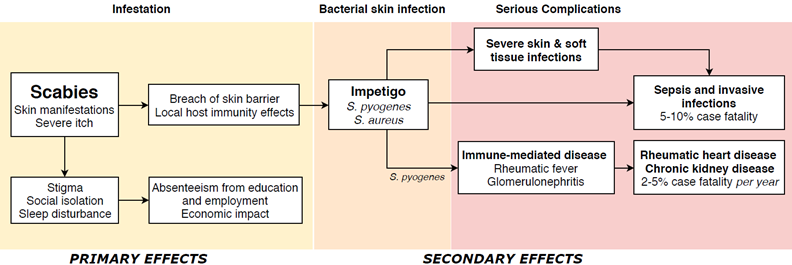What is scabies
Scabies is one of the most common dermatological conditions in the world, accounting for a substantial proportion of skin disease in developing countries. It is caused by a highly contagious and tiny mite that burrows into the skin. Aulus Cornelius Celsus (25 BC – 50 AD) the Roman encyclopedist and medical writer is credited with naming “scabies” after the Latin ‘scabere’ (to scratch).
Scabies mites burrow under the upper layer of the skin laying their eggs, resulting in intense itching. The common signs of scabies are papules or burrows in typical locations, such as the web spaces of the fingers and toes, wrists, buttocks, breasts in females, and genitals. Young children and the elderly may have more widespread locations, including palms, soles and scalp. The itching and rash cause poor sleep, stigma and social exclusion, absenteeism from education and employment, resulting in reduced learning potential for children and economic impact for families and communities.
Crusted scabies is a severe form of scabies. It is characterized by thick crusts over the skin, and in severe cases deep fissures. In contrast to common scabies, crusted scabies may not be itchy.
Individuals with scabies may scratch so much they draw blood. When the skin breaks, bacteria (particularly Staphylococcus aureus and Streptococcus pyogenes, Strep A) can enter the skin resulting in bacterial skin infections called impetigo. Impetigo can in turn be complicated by deeper skin infection such as abscesses, as well as serious invasive disease and sepsis. Impetigo can lead to immune mediated complications such as glomerulonephritis (kidney disease) and possibly acute rheumatic fever that can lead to rheumatic heart disease.
Post Streptococcal Glomerulonephritis (PSGN)
PSGN is caused by an autoimmune reaction to Strep A bacteria which affects the normal functioning of the kidneys. The vast majority of children who develop PSGN will recover, however recurrent episodes can contribute to long term kidney damage in adulthood.
Acute Rheumatic Fever (ARF) and Rheumatic Heart Disease (RHD)
ARF is an illness following an autoimmune response to the Strep A bacteria. The body’s immune system reacts to the infection, causing inflammation to the heart, joints, skin, and brain. This illness is of particular concern to the heart, where the inflammation frequently causes permanent damage and scarring of the heart valves. This damage to the heart valves is known as RHD, and is a serious, progressive chronic disease.
Figure 1. Primary and secondary effects of scabies infestation

Engelman D, et al. The public health control of scabies: priorities for research and action. Lancet Infect Dis. 2019; 394: 81-92.





